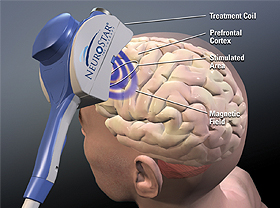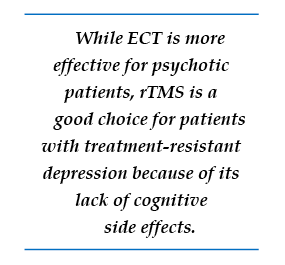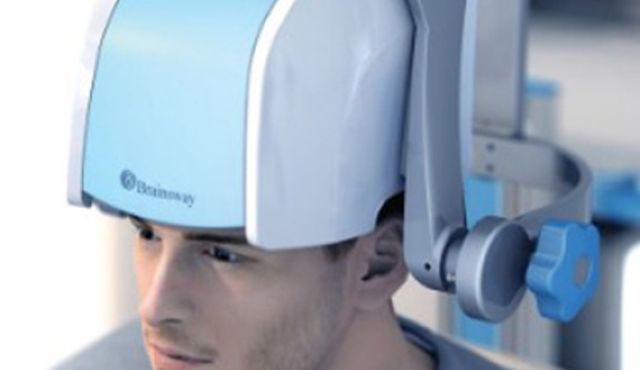Second RTMS Device Approved for Treatment-Resistant Depression
In 2008, the Federal Drug Administration approved the Neuronetics company’s Neuro-Star system for delivering repeated transcranial magnetic stimulation to patients with treatment-resistant depression. In rTMS treatment, an electromagnetic coil is placed against the forehead and magnetic pulses that can penetrate the scalp are converted into small electrical currents that stimulate neurons in the brain. Now the FDA has approved a second device manufactured by Brainsway Ltd.
In 2012, Brainsway released data from their double-blind, multicenter controlled trials of the device. After five weeks of treatment, 30.4% of the patients who received the rTMS treatment achieved remission of their depression, twice the rate of remission among the patients who received a sham procedure instead.
Editor’s Note: These data showing slightly higher response rates than seen in two trials by Neuronetics confirm the efficacy of rTMS in patients whose depression persists after one or more trials with antidepressant medications. The efficacy of rTMS in those patients who have failed to respond to multiple antidepressant medications remains to be further defined, as do the optimal stimulation parameters to achieve the best results in this difficult-to-treat sub-group of patients.
RTMS in Depression: Positive Effects in Long-Term Follow-Up
Repetitive transcranial magnetic stimulation (rTMS) is a non-invasive treatment that uses a rapidly changing magnetic field to target neurons, creating a weak electric current. It is used to treat depression, strokes, and other neurological and psychiatric conditions. At the 2013 meeting of the American Psychiatic Association (APA), researcher Linda L. Carpenter reported on new findings about the long-term effects of rTMS.
In the new research, which was led by Mark Andrew Demitrack, 307 patients with unipolar depression who had not responded well to previous antidepressant treatment were given rTMS. They were treated in 43 different clinical practices and administered rTMS according to their evaluating physician, following FDA guidelines. Of the 307 patients who began the study, 264 benefited from initial treatments with rTMS, were tapered off rTMS, and agreed to participate in a one-year follow-up period, by the end of which 68% had improved and 40.4% had achieved complete remission as measured by the Clinical Global Impressions scale for severity of illness.
However, some study participants (30.2%) had worsened by the first follow-up assessment at the 3-month mark, and rTMS had to be re-introduced.
RTMS Improves Working Memory In Patients With Schizophrenia
 Repetitive transcranial magnetic stimulation (rTMS) may improve working memory in patients with schizophrenia, according to a small study published by Zafiris J. Daskalakis and colleagues in Biological Psychiatry in 2013. Patients with schizophrenia received either 20 Hz rTMS over the left and right prefrontal cortex or a sham treatment, and the rTMS improved working memory on a particular task, the n-back task, wherein patients are asked to recall whether a stimulus they’re currently viewing is the same as the previous one they viewed, or one they viewed several times back. Twenty sessions of rTMS over a period of 4 weeks brought memory back to the levels seen in normal controls.
Repetitive transcranial magnetic stimulation (rTMS) may improve working memory in patients with schizophrenia, according to a small study published by Zafiris J. Daskalakis and colleagues in Biological Psychiatry in 2013. Patients with schizophrenia received either 20 Hz rTMS over the left and right prefrontal cortex or a sham treatment, and the rTMS improved working memory on a particular task, the n-back task, wherein patients are asked to recall whether a stimulus they’re currently viewing is the same as the previous one they viewed, or one they viewed several times back. Twenty sessions of rTMS over a period of 4 weeks brought memory back to the levels seen in normal controls.
Editor’s Note: Since many patients with bipolar disorder also have deficits in prefrontal-based memory and performance even when euthymic, it will be important to see if rTMS would also be helpful in these patients. RTMS at 20 Hz increases neuronal activity as measured by PET scan of the prefrontal cortex and other regions of the brain, and this lasts for at least 48 hours after each treatment.
Since many patients with schizophrenia and bipolar disorder show deficits in prefrontal activity at baseline, the normalization of these alterations could relate to the memory improvement. This proposition could be tested relatively easily.
RTMS Versus ECT
 We’ve been posting about repeated transcranial magnetic stimulation (rTMS), a treatment in which a magnetic field is applied to a patient’s head, where it is able to affect tissue 2-3 centimeters into the brain.
We’ve been posting about repeated transcranial magnetic stimulation (rTMS), a treatment in which a magnetic field is applied to a patient’s head, where it is able to affect tissue 2-3 centimeters into the brain.
In randomized, controlled, head to head comparisons of electroconvulsive therapy (ECT) and repeated transcranial magnetic stimulation (rTMS), ECT often proves superior, particularly for a more severe psychotic or medically compromised patient. Nonetheless, for a more routine patient with non-psychotic depression, multiple studies have shown approximate equivalence of rTMS and ECT, while rTMS may have a superior benefit-to-risk ratio because it brings less risk of cognitive dysfunction. Thus, given almost equivalent efficacy for some subgroups of depressed patients, and a clear advantage for rTMS in terms of lack of cognitive side effects, this editor/clinician would recommend a course of rTMS prior to a series of ECT for the subgroup of non-emergency treatment-resistant depressed patients.
However, for highly treatment-refractory, severe, and particularly psychotic depression, few treatments appear to approach the efficacy and rapid response onset of electroconvulsive therapy (ECT). ECT as given in the modern era involves anesthesia and muscle paralysis while the patient is mechanically ventilated in order to prevent any damage from muscle contractions during the seizure. Read more
RTMS Parameters
 As we wrote yesterday, repeated transcranial magnetic stimulation (rTMS) is a treatment in which a magnetic field is applied to a patient’s head, where it is able to affect tissue 2-3 centimeters into the brain. The major studies of rTMS, by O’Reardon and colleagues (2007) and George et al. (2010), were performed with patients who were medication-free during the course of rTMS treatment. However, it is routine clinical practice to use rTMS as an adjunctive treatment to ongoing antidepressant therapy, and in these cases, response rates appear to be close to 50%, even in patients with considerable treatment resistance to prior antidepressants.
As we wrote yesterday, repeated transcranial magnetic stimulation (rTMS) is a treatment in which a magnetic field is applied to a patient’s head, where it is able to affect tissue 2-3 centimeters into the brain. The major studies of rTMS, by O’Reardon and colleagues (2007) and George et al. (2010), were performed with patients who were medication-free during the course of rTMS treatment. However, it is routine clinical practice to use rTMS as an adjunctive treatment to ongoing antidepressant therapy, and in these cases, response rates appear to be close to 50%, even in patients with considerable treatment resistance to prior antidepressants.
Using the FDA-approved parameters, treatment is typically delivered with with an rTMS machine that stimulates the left prefrontal cortical area of the brain at a stimulation intensity of 120% of the patient’s motor threshold at a frequency of magnetic impulses of 10 per second or 10 Hz. The motor threshold is the intensity of stimulation necessary to cause the thumb to move when the motor cortex is stimulated, but the treatment is given over the frontal cortex which does not produce any movements or other sensations.
Each treatment lasts for about 20 minutes and does not require any anesthesia or premedication. The patient is awake and alert during the procedure, and cognitive side effects are minimal. Patients occasionally experience some pain from contraction of the scalp muscles under the magnet.
The rapid reversal of the magnetic field occurring ten times per second induces electrical stimulation of the brain at the same frequency and causes discharge of neurons. High frequency (at 10 or 20Hz) neuronal activity appears to increase activity (blood flow or metabolism) in the brain, while lower frequency stimulation, such as at 1 Hz, appears to decrease brain activity. In both cases, the effects last at least 48 hours after the last of a two- or three-week series of treatments. RTMS increases brain-derived neurotrophic factor (BDNF) in the brain, and BDNF is released when nerves fire at a fast frequency. The release of BDNF appears to be necessary for long-term learning and memory.
Sitting passively versus receiving therapy during rTMS
In clinical practice, most treatments are administered by a technician. However, in some instances, clinicians engage patients in forms of active psychotherapy while they are receiving the rTMS. Read more
Repeated Transcranial Magnetic Stimulation Now More Widely Available
 As reported in the BNN last year, a study by George and colleagues that was published in the Archives of General Psychiatry provided independent support and replication of earlier findings that active repeated transcranial magnetic stimulation (rTMS) is more effective than a sham procedure in the treatment of partially drug-resistant depressed patients.
As reported in the BNN last year, a study by George and colleagues that was published in the Archives of General Psychiatry provided independent support and replication of earlier findings that active repeated transcranial magnetic stimulation (rTMS) is more effective than a sham procedure in the treatment of partially drug-resistant depressed patients.
RTMS is a treatment in which a magnetic field is applied to a patient’s head, where it is able to affect tissue 2-3 centimeters into the brain. According to Neuronetics, the company that produces the rTMS machine, “The magnetic field passes through the hair, scalp, and skull and into the prefrontal cortex unimpeded. This method allows for precise, targeted stimulation, minimizing the stimulation of brain tissue not involved in mood.” The Federal Drug Administration approved the Neuronetics rTMS machine after a large, multi-center sham-controlled study was published by O’Reardon et al. in Biological Psychiatry in 2007. Since the FDA approval, availability of rTMS treatment and insurance reimbursement for the procedure have improved.
Covering the cost of treatment
A number of hospitals and private practitioners around the country are now able to offer treatment with rTMS. The Neuronetics website allows patients to search for sites where the treatment is offered. While a treatment sequence typically consisting of treatment five times a week for four to six weeks is relatively expensive (often in the range of $8,000-$12,000 or more for the series), some health insurance plans will now (perhaps after some argument and negotiation) cover some of the cost of treatment. It was estimated by Neuronetics personnel that about 75% of the time, with the assistance of Neuronetics and the physician staff delivering the rTMS, such insurance coverage can successfully be arranged. Neuronetics suggested that even if the claim is initially rejected, many treatment series will eventually be covered.
Neuronetics also provides assistance for patients with annual income under $42,000. These patients may be able to receive treatment free of charge. In addition, for those who have a higher income but are uninsured, Neuronetics offers a loan program for the gradual repayment of the cost of the procedure.
Stay tuned for more articles about rTMS this week!
rTMS for Adolescent Depression
In an abstract presented at the 65th Annual Scientific Convention of the Society of Biological Psychiatry, Christopher Wall reported that treatment with rTMS (10 Hz at 120% of motor threshold) was successful in the treatment of adolescent depression.
These data from an open (as opposed to blind) study deserve further and more systematic investigation. Alternatives to antidepressant drug treatment are desirable for adolescents with depression since increases in suicidal ideation are a potential side effect during the first two months after initiation of pharmacological antidepressant treatment in teens. (Suicidal ideation and actions among adolescents decrease with longer-term antidepressant treatment, especially when it is used in conjunction with cognitive/behavioral psychotherapy.) Children and adolescents treated with antidepressants may also be at higher risk for switching into mania than adults treated with antidepressants.
Editor’s Note: The rTMS parameters used in this study are the same as those used successfully in adults with depression in the two large positive multi-center sham-controlled studies (one by industry and one by the National Institute of Mental Health) mentioned in yesterday’s article.
New Developments in Repeated Transcranial Magnetic Stimulation (rTMS)
 At the 65th Annual Scientific Convention of the Society of Biological Psychiatry, several findings related to repeated transcranial magnetic stimulation (rTMS) were reported.
At the 65th Annual Scientific Convention of the Society of Biological Psychiatry, several findings related to repeated transcranial magnetic stimulation (rTMS) were reported.
E. Baron Short reported that two weeks of 10 Hz rTMS at 120% of motor threshold (MT) was highly effective in the treatment of fibromyalgia. Pain ratings decreased 45% by day six and 80% by day 10 in this randomized sham-controlled double-blind study.
Also at the convention, Motoaki Nakamura reported that either 1 Hz or 20 Hz rTMS at 90-100% of motor threshold over left prefrontal cortex in depressed patients increased gray matter in left dorsolateral prefrontal cortex and left hippocampus in association with almost 50% reductions in Hamilton depression rating scale scores and associated increases in performance on the Wisconsin card sort test. Read more
Brain Stimulation for Treatment-Resistant Depression
There are many methods of stimulating the brain directly, ranging from the very invasive to the non-invasive. Below we discuss deep brain stimulation, frontal lobe and vagal nerve stimulation, repeated transcranial magnetic stimulation, electroconvulstive therapy (in particular the new right unilateral ultra-brief pulse method), and low level magnetic fields.

- Repetitive transcranial magnetic stimulation (rTMS) is a technique for noninvasive stimulation of the adult brain. Stimulation is produced by generating a brief, high-intensity magnetic field by passing a brief electric current through a magnetic coil. Compared with the growing number of clinical trial with rTMS, there are surprisingly few animal studies on its basic mechanisms of action, constraining the ability to perform hypothesis-driven clinical studies.
This is an Open Access image distributed under the terms of the Creative Commons Attribution License (http://creativecommons.org/licenses/by/2.0), which permits unrestricted use, distribution, and reproduction in any medium, provided the original work is properly cited. From: Arias-Carrión International Archives of Medicine 2008 1:2 doi:10.1186/1755-7682-1-2
Deep Brain Stimulation
At the American Psyciatric Association meeting in San Francisco in May 2009, Giacobbe et al. reported on the results of deep brain stimulation of an anterior-ventral part of the prefrontal cortex called the subgenual cingulate cortex in patients with refractory major depressive disorder. In deep brain stimulation, electrodes are inserted directly into the brain. Twenty-one patients received this treatment in an open study at sites in Canada at McGill University, the University of British Columbia, and the University of Toronto. This multi-center trial replicated results reported by Mayberg et al. (2005) with stimulation of what is also called Broadman’s area 25, or the part of the prefrontal cortex just under the anterior part of the corpus callosum (which carries fiber tracts between the left and right sides of the brain).
Read more
rTMS Effective in Major Depression
Mark George from the Medical University of South Carolina presented a sham-controlled, multi-site, randomized trial of repeated transcranial magnetic stimulation (rTMS) in 199 antidepressant-free patients with unipolar non-psychotic major depression. The rTMS was delivered to the left prefrontal cortex for 37.5 minutes at 120% of motor threshold (MT), with a 10 Hz, four-second train duration and 26-second inter-train interval, yielding 3000 pulses/session, with a figure-of-eight solid core coil. Compared with the sham treatment (which plays the same role a placebo would in a drug trial), active rTMS had a significant effect (p = .015), with 14% of patients remitting on the treatment compared with 5% on the sham procedure. Thus, the odds of attaining remission (the primary outcome measure) were several times greater with active rTMS than sham.
The number needed to treat (NNT), a measure of the number of patients who would need to be treated with active rTMS in order to get one more responder compared to the number of responders seen on sham rTMS (the smaller the number, the more effective the treatment) was 12. However, as in other previous studies, most of the remitters had prior low antidepressant-rated degrees of treatment resistance. When the blind study was complete and patients were openly given rTMS treatments (a practice known as open label extension), approximately 30% of the patients from each condition were able to achieve remission.
EDITOR’S NOTE: This large study, sponsored by NIMH rather than the pharmaceutical industry, confirms previous industry-related findings that active rTMS is more effective than sham in the treatment of major depressive disorder. These data also conform to recent meta-analyses of many smaller studies indicating that high intensity rTMS treatment is clinically effective for major depression. In prior rTMS studies, those with bipolar depression appeared to respond at about the same rate as those with unipolar illness, suggesting the possibility that these findings might also generalize to those with bipolar disorder, although this remains to be studied more systematically.
This study showed that patients with greater degrees of initial treatment resistance had less optimal outcomes to active rTMS. Some studies also show that electro-convulsive therapy (ECT) decreases in effectiveness in those with greater degrees of treatment-resistance. Response rates to ECT are approximately 40-50% in those with high degrees of treatment-resistance compared with 60-80% in those without. The rTMS data suggest that the treatment as studied may be a useful alternative to antidepressants for some patients with major depression, but it may not be an optimal approach for those with the highest degrees of treatment resistance. Further studies are warranted in patients with high treatment resistance in order to define optimal stimulation parameters that may be more successful for them.



